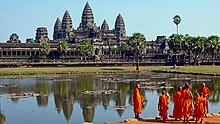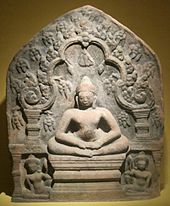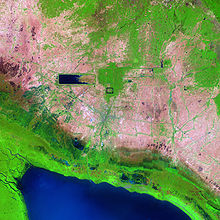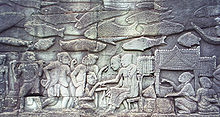Suryavarman II — Angkor Wat[edit]
The 12th century was a time of conflict and brutal power struggles. Under Suryavarman II (reigned 1113–1150) the kingdom united internally[7]:113 and the largest temple of Angkor was built in a period of 37 years: Angkor Wat, dedicated to the god Vishnu. In the east, his campaigns against Champa, and Dai Viet, were unsuccessful,[7]:114 though he did sack Vijaya in 1145 and depose Jaya Indravarman III.[24]:75–76 The Khmers occupied Vijaya until 1149, when they were driven out by Jaya Harivarman I.[4]:160 Suryavarman II sent a mission to the Chola dynasty of south India and presented a precious stone to the Chola Emperor Kulothunga Chola I in 1114.[25][26]
Another period followed in which kings reigned briefly and were violently overthrown by their successors. Finally, in 1177 the capital was raided and looted in a naval battle on the Tonlé Sap lake by a Cham fleet under Jaya Indravarman IV, and Tribhuvanadityavarman was killed.[4]:164[24]:78
Jayavarman VII — Angkor Thom[edit]
King Jayavarman VII (reigned 1181–1219) was generally considered as Cambodia's greatest king. He had already been a military leader as a prince under previous kings. After the Cham had conquered Angkor, he gathered an army and regained the capital. He ascended the throne and continued the war against the neighbouring eastern kingdom for another 22 years, until the Khmer defeated Champa in 1203 and conquered large parts of its territory.[4]:170–171[24]:79–80
Jayavarman VII stands as the last of the great kings of Angkor, not only because of his successful war against the Cham, but also because he was not a tyrannical ruler in the manner of his immediate predecessors. He unified the empire and carried out noteworthy building projects. The new capital, now called Angkor Thom (literally: "Great City"), was built. In the centre, the king (himself a follower of Mahayana Buddhism) had constructed as the state temple the Bayon,[5]:378–382 with towers bearing faces of the boddhisattvaAvalokiteshvara, each several metres high, carved out of stone. Further important temples built under Jayavarman VII were Ta Prohm for his mother, Preah Khan for his father,[5]:388–389 Banteay Kdei, and Neak Pean, as well as the reservoir of Srah Srang. An extensive network of roads was laid down connecting every town of the empire, with rest-houses built for travellers and he established a total of 102 hospitals across his realm.[4]:173,176
Jayavarman VIII — the last blooming[edit]
After the death of Jayavarman VII, his son Indravarman II (reigned 1219–1243) ascended the throne.[4]:180–181 Like his father, he was a Buddhist, and he completed a series of temples begun under his father's rule. As a warrior he was less successful. In the year 1220, under mounting pressure from increasingly powerful Đại Việt, and its Cham alliance, the Khmer withdrew from many of the provinces previously conquered from Champa. In the west, his Thai subjects rebelled, establishing the first Thai kingdom at Sukhothai and pushing back the Khmer. In the following 200 years, the Thais would become the chief rivals of Kambuja.
Indravarman II was succeeded by Jayavarman VIII (reigned 1243–1295). In contrast to his predecessors, Jayavarman VIII was a devotee of the Hindu deity Shiva and an aggressive opponent of Buddhism, destroying many Buddha statues in the empire and converting Buddhist temples to Hindu temples.[7]:133 From the outside, the empire was threatened in 1283 by the Mongols under Kublai Khan's general Sogetu (sometimes known as Sagatu or Sodu), who was the governor of Guangzhou, China.[27] The king avoided war with his powerful opponent, who ruled all of China, by paying annual tribute, starting in 1285.[4]:192[27] Jayavarman VIII's rule ended in 1295 when he was deposed by his son-in-law Srindravarman (reigned 1295–1309). The new king was a follower of Theravada Buddhism, a school of Buddhism that had arrived in southeast Asia from Sri Lanka and subsequently spread through most of the region.
In August 1296, the Chinese diplomat Zhou Daguan arrived at Angkor and recorded, "In the recent war with the Siamese, the country was utterly devastated."[4]:211[24]:90 He remained at the court of King Srindravarman until July 1297. He was neither the first nor the last Chinese representative to visit Kambuja. His stay is notable, however, because Zhou Daguan later wrote a detailed report on life in Angkor. His portrayal is today one of the most important sources of understanding historical Angkor. Alongside descriptions of several great temples (the Bayon, the Baphuon, Angkor Wat) – his account informs us that the towers of the Bayon were once covered in gold – the text also offers valuable information on the everyday life and the habits of the inhabitants of Angkor.
Decline[edit]
By the 14th century, the Khmer empire suffered a long, arduous, and steady decline. Historians have proposed different causes for the decline: the religious conversion from Vishnuite-Shivaite Hinduism to Theravada Buddhism that affected social and political systems, incessant internal power struggles among Khmer princes, vassal revolt, foreign invasion, plague, and ecological breakdown.
For social and religious reasons, many aspects contributed to the decline of the Khmer empire. The relationship between the rulers and their elites was unstable – among the 27 Angkorian rulers, eleven lacked a legitimate claim to power, and civil wars were frequent. The Khmer empire focused more on the domestic economy and did not take advantage of the international maritime network. In addition, the input of Buddhist ideas conflicted and disturbed the state order built under the predominant Hinduism.[28]
Conversion of faith[edit]
The last Sanskrit inscription is dated 1327 and describes the succession of Indrajayavarman by Jayavarmadiparamesvara.[4]:228 Historians suspect a connection with the kings' adoption of Theravada Buddhism: they were therefore no longer considered "devarajas", and there was no need to erect huge temples to them, or rather to the gods under whose protection they stood. The retreat from the concept of the devaraja may also have led to a loss of royal authority and thereby to a lack of workers. The water-management apparatus also degenerated, meaning that harvests were reduced by floods or drought. While previously three rice harvests per year were possible – a substantial contribution to the prosperity and power of Kambuja – the declining harvests further weakened the empire.
Looking at the archaeological record, however, archaeologists noticed that not only were the structures ceasing to be built, but the Khmer's historical inscription was also lacking from roughly 1300–1600. With this lack of historical content, there is unfortunately very limited archaeological evidence to work with. Archaeologists have been able to determine that the sites were abandoned and then reoccupied later by different people.[29]
There is evidence that the Black Death had affected the situation described above, as the plague first appeared in China around 1330 and reached Europe around 1345. Most seaports along the line of travel from China to Europe felt the impact of the disease, which had a severe impact on life throughout South East Asia.
Foreign pressure[edit]
The western neighbour of the Khmer, the first Thai kingdom of Sukhothai, after repelling Angkorian hegemony, was conquered by another stronger Thai kingdom in the lower Chao Phraya Basin, Ayutthaya, in 1350. From the fourteenth century, Ayutthaya became Angkor's rival.[4]:222–223 Angkor was besieged by the Ayutthayan king Uthong in 1352, and following its capture the next year, the Khmer monarch was replaced with successive Siamese princes. Then in 1357, the Khmer king Suryavamsa Rajadhiraja regained the throne.[4]:236 In 1393, the Ayutthayan king Ramesuan besieged Angkor again, capturing it the next year. Ramesuan's son ruled Khmer a short time before being assassinated. Finally, in 1431, the Khmer king Ponhea Yat abandoned Angkor as indefensible, and moved to the Phnom Penh area.[4]:236–237
The new centre of the Khmer kingdom was in the southwest, at Oudong in the region of today's Phnom Penh. However, there are indications that Angkor was not completely abandoned. One line of Khmer kings may have remained there, while a second moved to Phnom Penh to establish a parallel kingdom. The final fall of Angkor would then be due to the transfer of economic – and therewith political – significance, as Phnom Penh became an important trade centre on the Mekong. Besides, severe droughts and ensuing floods were considered as one of the contributing factors to its fall.[30] The empire focused more on regional trade after the first drought.[31] Overall, climate change, costly construction projects, and conflicts over power between the royal family sealed the end of the Khmer empire.
Ecological breakdown[edit]
Ecological failure and infrastructural breakdown is a new alternative theory regarding the end of the Khmer Empire. Scientists working on the Greater Angkor Project believe that the Khmers had an elaborate system of reservoirs and canals used for trade, transportation, and irrigation. The canals were used for harvesting rice. As the population grew there was more strain on the water system. During the fourteenth and fifteenth centuries, there were also severe climatic changes impacting the water management system. Periods of drought led to decreases in agricultural productivity, and violent floods due to monsoons damaged the infrastructure during this vulnerable time.[30]To adapt to the growing population, trees were cut down from the Kulen hills and cleared out for more rice fields. That created rain runoff carrying sediment to the canal network. Any damage to the water system would have enormous consequences.[32]
Angkor after the 15th century[edit]
In any event, there is evidence for a further period of use of Angkor. Under the rule of King Barom Reachea I (reigned 1566–1576), who temporarily succeeded in driving back the Thai, the royal court was briefly returned to Angkor. Inscriptions from the 17th century testify to Japanese settlements alongside those of the remaining Khmer.[33] The best-known inscription tells of Ukondafu Kazufusa, who celebrated the Khmer New Year there in 1632.[34] However, in following decades the Japanese community was absorbed into the local Khmer community, owing to the lack of new Japanese arrivals and very little possibility of renewing their community.[33]
Culture and society[edit]
Further information: The Customs of Cambodia
Much of what is known of the ancient Khmer society comes from the many bas-reliefs and also the first-hand Chinese accounts of Zhou Daguan, which provide information on 13th-century Cambodia and earlier. The bas-reliefs of Angkor temples, such as those in Bayon, describe everyday life of the ancient Khmer kingdom, including scenes of palace life, naval battles on the river or lakes, and common scenes of the marketplace.
Economy and agriculture[edit]
The ancient Khmers were a traditional agricultural community, relying heavily on rice farming. The farmers, who formed the majority of kingdom's population, planted rice near the banks of the lake or river, in the irrigated plains surrounding their villages, or in the hills when lowlands were flooded. The rice paddies were irrigated by a massive and complex hydraulics system, including networks of canals and barays, or giant water reservoirs. This system enabled the formation of large-scale rice farming communities surrounding Khmer cities. Sugar palm trees, fruit trees, and vegetables were grown in the orchards by the villages, providing other sources of agricultural produce such as palm sugar, palm wine, coconut, various tropical fruits, and vegetables.
Located by the massive Tonlé Sap lake, and also near numerous rivers and ponds, many Khmer people relied on fresh water fisheries for their living. Fishing gave the population their main source of protein, which was turned into prahok — dried or roasted or steamed fish paste wrapped in banana leaves. Rice was the main staple along with fish. Other sources of protein included pigs, cattle, and poultry, which were kept under the farmers' houses, which were on stilts to protect them from flooding.
The marketplace of Angkor contained no permanent buildings; it was an open square where the traders sat on the ground on woven straw mats and sold their wares. There were no tables or chairs. Some traders might be protected from the sun with a simple thatched parasol. A certain type of tax or rent was levied by officials for each space occupied by traders in the marketplace. The trade and economy in the Angkor marketplace were mainly run by women.











No comments:
Post a Comment